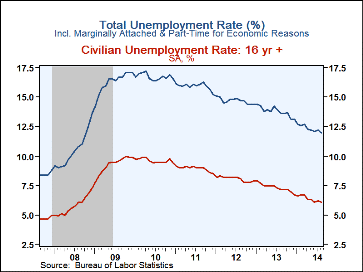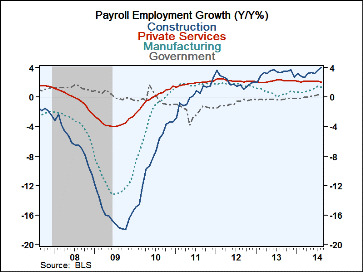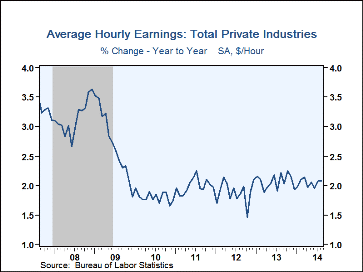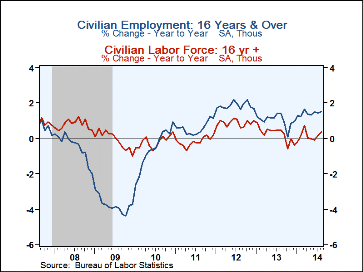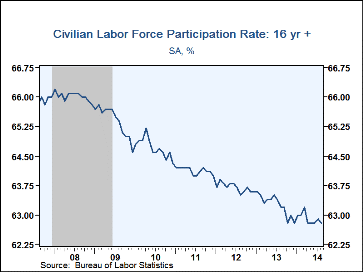 Global| Sep 05 2014
Global| Sep 05 2014U.S. Payrolls Post Disappointing Increase; Jobless Rate Ticks Lower
by:Tom Moeller
|in:Economy in Brief
Summary
Nonfarm payrolls gained 142,000 (1.8% y/y) during August following increases of 212,000 and 267,000 during the prior two months. The rise was the weakest since December and disappointed expectations for a 220,000 increase in the [...]
Nonfarm payrolls gained 142,000 (1.8% y/y) during August following increases of 212,000 and 267,000 during the prior two months. The rise was the weakest since December and disappointed expectations for a 220,000 increase in the Action Economics Forecast Survey. The unemployment rate matched expectations and dipped to 6.1%, its lowest level since September 2008. The overall unemployment rate, including marginally attached workers and those employed part-time for economic reasons, fell to 12.0%.
From the payroll employment survey, factory sector employment was flat (1.4% y/y). Retail trade jobs actually fell 8,400 (+1.6% y/y) while transportation & warehousing employment gained just 1,200 (3.4% y/y). Financial sector jobs rose 7,000 (0.8% y/y) but information sector employment declined 3,000 (-0.1% y/y) and education services fell 6,300 (+0.9% y/y). Continuing to show strength was employment in the professional & business services sector where jobs rose 47,000 (3.4% y/y) as temporary employment increased 13,000 (8.0% y/y). Health care & social assistance hiring improved 42,700 (1.9% y/y). Leisure & hospitality jobs increased 15,000 (2.4% y/y), but that was off sharply from the pace of recent years. Construction payrolls increased 20,000. Government sector jobs improved 8,000 (0.2% y/y) as local area employment rose 4,000 (0.4% y/y); federal government jobs improved 3,000 (-1.2% y/y) and state government jobs gained a minimal 1,000 (0.3% y/y).
The length of the average workweek held steady at 34.5 hours for the sixth straight month. That left aggregate hours worked up 0.1% m/m and 1.8% (AR) this quarter versus Q2.
Average hourly earnings posted a 0.2% increase (2.1% y/y) after a 0.1% July improvement. Private service sector earnings rose 0.3% (2.0% y/y) led by 0.4% gains in the financial sector (1.9% y/y) and the leisure & hospitality industries (3.1% y/y). Factory sector earnings rose a steady 0.2% (2.1% y/y).
The household employment survey indicated that the unemployment rate edged down to 6.1%. The decline occurred as employment improved 16,000 (1.5% y/y) but the labor force fell 64,000 (+0.3% y/y). With that decline, the labor force participation rate equaled its cycle low of 62.8%, its lowest level since early-1978. The number of individuals not in the labor force rose 1.9% y/y.
For men, the unemployment was at 6.2%. For women, the unemployment was at 6.1%. Unemployment amongst teenagers was 20.2%; for black teens, it was 34.9% and for whites it was 18.3%. For individuals over age 20, the jobless rate was 5.7%, 10.7% for adult blacks and 4.8% for whites.
The unemployment rate for individuals with less than a high school diploma was 9.1% while for high school graduates but no college it equaled 6.2%. For those with some college but no degree, the jobless rate was 5.4% and for college graduates and higher, it was 3.2%.
The figures referenced above are available in Haver's USECON database. Additional detail can be found in the LABOR and in the EMPL databases. The expectation figures are from Action Economics and are in the AS1REPNA database.
| Employment: (M/M Chg., 000s) | Aug | Jul | Jun | Y/Y | 2013 | 2012 | 2011 |
|---|---|---|---|---|---|---|---|
| Payroll Employment | 142 | 212 | 267 | 1.8% | 1.7% | 1.7% | 1.2% |
| Previous | -- | 209 | 298 | -- | -- | -- | -- |
| Manufacturing | 0 | 28 | 21 | 1.4 | 0.7 | 1.7 | 1.7 |
| Construction | 20 | 31 | 8 | 4.0 | 3.3 | 2.1 | 0.2 |
| Private Service Producing | 112 | 146 | 226 | 2.1 | 2.2 | 2.2 | 1.9 |
| Government | 8 | -1 | 7 | 0.2 | -0.3 | -0.8 | -1.8 |
| Average Weekly Hours - Private Sector | 34.5 | 34.5 | 34.5 | 34.5 (Aug'13) |
34.5 | 34.4 | 34.3 |
| Average Private Sector Hourly Earnings (%) | 0.2 | 0.1 | 0.3 | 2.1 | 2.1 | 1.9 | 2.0 |
| Unemployment Rate (%) | 6.1 | 6.2 | 6.1 | 7.2 (Aug'13) |
7.4 | 8.1 | 8.9 |
Tom Moeller
AuthorMore in Author Profile »Prior to joining Haver Analytics in 2000, Mr. Moeller worked as the Economist at Chancellor Capital Management from 1985 to 1999. There, he developed comprehensive economic forecasts and interpreted economic data for equity and fixed income portfolio managers. Also at Chancellor, Mr. Moeller worked as an equity analyst and was responsible for researching and rating companies in the economically sensitive automobile and housing industries for investment in Chancellor’s equity portfolio. Prior to joining Chancellor, Mr. Moeller was an Economist at Citibank from 1979 to 1984. He also analyzed pricing behavior in the metals industry for the Council on Wage and Price Stability in Washington, D.C. In 1999, Mr. Moeller received the award for most accurate forecast from the Forecasters' Club of New York. From 1990 to 1992 he was President of the New York Association for Business Economists. Mr. Moeller earned an M.B.A. in Finance from Fordham University, where he graduated in 1987. He holds a Bachelor of Arts in Economics from George Washington University.



